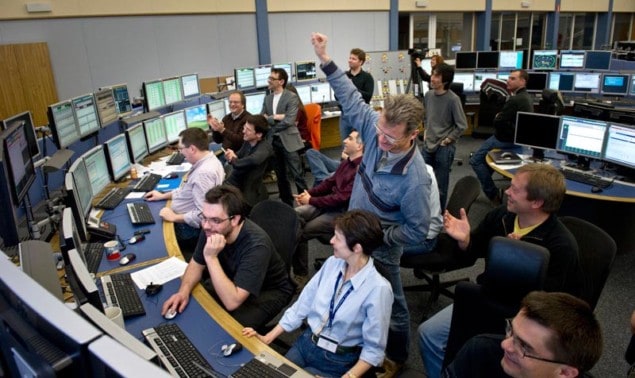
CERN has announced that its Large Hadron Collider (LHC) will attempt the first collisions at 7 TeV on Tuesday 30 March – one week today.
Smashing together protons at this energy will set another benchmark for the highest energy yet achieved in a particle accelerator. More significantly, it will mark the beginning of the LHC physics programme, which will test and scrutinize the Standard Model of particle physics.
It’s a bit like firing needles across the Atlantic and getting them to collide halfway. Steve Myers, director for accelerators and technology, CERN
The announcement follows Friday’s news that two 3.5 TeV beams had been successfully circulated around the 27 km circumference of the LHC.
Playing down the hype
Despite the excitement at being so close to such a key milestone, CERN is careful to emphasize the uncertainties ahead. “The LHC is not a turnkey machine,” said CERN director general Rolf-Dieter Heuer. “The machine is working well, but we’re still very much in a commissioning phase and we have to recognize that the first attempt to collide is precisely that. It may take hours or even days to get collisions.”
This is a sentiment echoed by CERN’s director for accelerators and technology, Steve Myers. “Just lining the beams up is a challenge in itself: it’s a bit like firing needles across the Atlantic and getting them to collide halfway.”
Once 7 TeV collisions have been established, CERN’s plan is to run continuously for a period of 18–24 months, with a short technical stop at the end of 2010. Experiments will run throughout this time, with researchers expecting to accumulate one “inverse femtobarn” of data – roughly 10 trillion proton–proton collisions.
The broad aim of this research is to characterize the subatomic particles that emerge from these high-energy collisions, with perhaps the ultimate goal of confirming the existence (or non-existence) of the Higgs boson. This elusive particle is the last missing piece of the Standard Model of particle physics, and its discovery would confirm the most compelling explanation physicists have for how elementary particles acquire mass.
In pursuit of the Higgs
Although the Standard Model does not predict the mass of the Higgs boson, precision measurements of known Standard Model particles mean that its mass is unlikely to be more than 186 GeV. Meanwhile, direct searches made at CERN’s Large Electron–Positron Collider – the forerunner to the LHC – rule out a Higgs that is lighter than 114 GeV.
Running at 7 TeV, the LHC should have the best chance yet of confining the Higg’s mass, being 3.5 times more energetic than the Tevatron collider at Fermilab in the US, which until December was the world’s most energetic collider. What can be discovered, however, will depend largely on how heavy such new particles are and on how easy they are to spot among “background” processes taking place in the proton–proton collisions.
Following this current run, CERN plans to shut down the LHC in 2012 for a year or more to prepare it to go straight to maximum-energy 14 TeV collisions in 2013.



